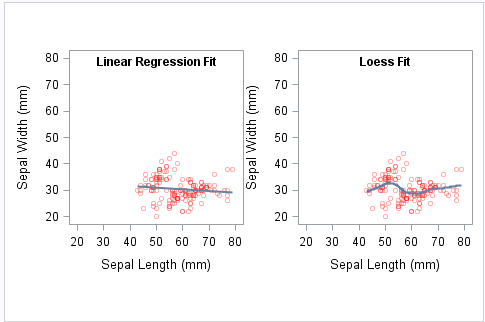Example of Creating a Template
This example
creates a two-celled graph that shows linear and loess regression
fits. The template uses a LATTICE layout with two columns.
proc template;
define statgraph mygraph;
dynamic XVAR YVAR;
begingraph / designwidth=480px designheight=320px;
layout lattice / columns=2;
layout overlayequated / equatetype=square;
entry "Linear Regression Fit" /
valign=top textattrs=(weight=bold);
scatterplot x=XVAR y=YVAR / markerattrs=(color=red) datatransparency=.7;
regressionplot x=XVAR y=YVAR;
endlayout;
layout overlayequated / equatetype=square;
entry "Loess Fit" /
valign=top textattrs=(weight=bold);
scatterplot x=XVAR y=YVAR / markerattrs=(color=red) datatransparency=.7;
loessplot x=XVAR y=YVAR;
endlayout;
endlayout;
endgraph;
end;
run;
proc sgrender data=sashelp.iris template=mygraph;
dynamic xvar="SepalLength" yvar="SepalWidth";
run;
Here is a brief description
of the code.
-
The outer LAYOUT block contains two nested LAYOUT blocks, one for each overlay cell in the lattice. Each cell contains a scatter plot and a fit plot. The main distinction between the two cells is the type of fit plot. The first cell contains a regression plot and the second cell contains a loess plot.An ENTRY statement specifies the text for each cell title. The title for the first cell is "Linear Regression Fit." In the second LAYOUT block, the title is "Loess Fit."The MARKERATTRS= option in the SCATTERPLOT statement specifies a red color for the scatter plot markers. In addition, 70% transparency is assigned to the scatter plot to increase the visibility of the fit plot.
layout overlayequated / equatetype=square; entry "Linear Regression Fit" / valign=top textattrs=(weight=bold); scatterplot x=XVAR y=YVAR / markerattrs=(color=red) datatransparency=.7; regressionplot x=XVAR y=YVAR; endlayout; layout overlayequated / equatetype=square; entry "Loess Fit" / valign=top textattrs=(weight=bold); scatterplot x=XVAR y=YVAR / markerattrs=(color=red) datatransparency=.7; loessplot x=XVAR y=YVAR; endlayout;
